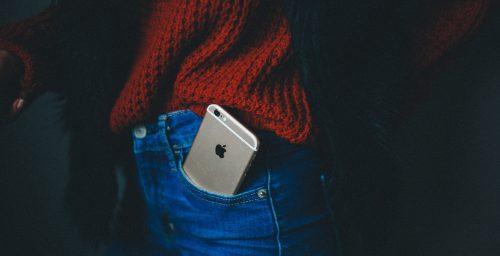Pockets On Women’s Clothes Matter More Than You Think

I’d been working in Corporate America for a little over a year when I decided to finally upgrade my iPhone 5 to an iPhone 6s. While I was extremely disappointed that a newer 4-inch model wasn’t available, I was excited for a functioning smartphone that would hold all of my music in one place. The thing I didn’t expect from the upgrade…it wasn’t pocket-friendly!
While the iPhone 5 was a breeze to slip into a pant pocket, my new iPhone 6S wasn’t. It would stick out, and I quickly grew paranoid that it would fall out of my pocket whenever I sat down. Embarrassingly enough, that’s exactly what happened when I went to use the bathroom at work, and since then, I either kept the phone in my backpack or held it in my hand.
This wouldn’t have been a problem if women’s clothes had proper pockets. Not small. Not fake. Not zipped or sewn shut. Proper, man-sized pockets! Think about it – the average smartphone is 5.5 inches. Men’s pockets are 8.5 inches. Women’s pockets, on the other hand, are a measly 4.5 inches (and we’re expected to put keys somewhere)!

In her piece The Politics of Pockets, Chelsea G. Summers offers a social commentary on the pocket situation: “Men’s dress is designed for utility; women’s dress is designed for beauty. It’s not a giant leap to see how pockets, or the lack thereof, reinforce sexist ideas of gender. Men are busy doing things; women are busy being looked at. Who needs pockets?”
Pockets aren’t just sexist – they’re also political. According to Nicole Lyn Pesce, pockets are “a place to put important personal items that you need to be independent, such as ID cards, keys, money and checkbooks/credit cards.” If you didn’t have pockets to carry these things around in, what would you do? One option is to lug these items around in a bag or backpack. The other option is to have someone else carry them for you – a friend, parent, sibling, or significant other. In any of these alternatives, there’s a loss of mobility by not being able to slip something quickly into your pocket.
Looking at the history of women’s pockets, it turns out that where and how many pockets women had depended on where women stood in society at a given time. In the 17th century, women wore pockets tied around their waist. Following that was a shift in the 19th century, where women started carrying reticules (little handbags). Fast forward to the 1940s, and women were at work because of WWII and wore military-style uniforms, with large pockets! More progress came in the 1970s, where women’s jeans now had pockets in the front and back.

Where does that leave us today? In the 21st century, women’s clothing has a strong emphasis on fashion over function. In 2014, Mashable surveyed five fashion brands about pocket size following the iPhone 6 Plus’ debut. While executives at these brands considered making pockets bigger on women’s pants, little has changed in four years. In fact, designers seem to be more concerned with how pockets affect “the lines of the garment, making it sit strangely on a woman’s figure.”
It’s understandable that pockets won’t fit in every style of clothing, but this shouldn’t be a problem for clothing types that can easily support pockets: jackets, blazers, trousers, a-line skirts, dresses, etc. Brands that don’t address this are missing the point.
Everyone has things they need to carry around all the time. Why is it that women have to invest in a purse to carry around their personal items, but men don’t?
What will it take for brands to start valuing women’s comfort and needs when it comes to pockets?






